

These articles are summaries of the information in the full reports.

41% women and non-conforming individuals face verbal or physical sexual harassment at work.
On average, 30% of the over 2,000 media professionals surveyed by WAN-IFRA Women in News between November 2020 and September 2021 indicated they had been on the receiving end of verbal and/or physical sexual harassment at work. When segmented by gender, this figure jumps to on average 40% for women and non-gender conforming individuals. On average, 12% of male respondents reported being on the receiving end of sexual harassment.
Disturbingly, on average 1 in 10 of all respondents, indicated that they had been harassed 5 times or more.

1 in 10 respondents indicate they had been harassed 5 times or more.
Another worrisome trend across all 20 markets is an unwillingness to report incidents when they occur. On average, only 1 in 5 incidents of sexual harassment are formally or informally escalated within media organisations.
Also consistent across all 5 regions: an inadequate response rate on behalf of organisations upon receiving a complaint. On average, action is only taken by organisations in just over half of the reported cases. And when action is taken, the most common response is to “warn the perpetrator”.
The most frequently cited perpetrators of sexual harassment are fellow employees (39.3%), followed by direct supervisor (19%) or, a higher management (18.9%)
Verbal Harassment for women
Reporting rates by region also show some variation, with Central America revealing the highest level of reporting, at 26% and the Arab Region showing the lowest, at 15%.
When asked what discouraged reporting, the overwhelming response pointed to a lack of understanding or awareness around avenues to report incidents, and fear of repercussions if incidents are reported. Less than 11% of respondents reported knowing whether their organisations even had a sexual harassment policy.
Over the course of the 12-month study, WAN-IFRA Women in News conducted in-depth interviews with 85 senior media executives from 18 of 20 target countries. A consistent trend identified is the disconnect between perception and reality held by executives when it comes to understanding the scale of the problem within their media organisation or the industry generally in their particular market.
43.5% of the media executives interviewed reported that they themselves had experienced sexual harassment. However within this same group, only 27% feel sexual harassment is still an issue in the industry. This is compounded by a lack of awareness around their own sexual harassment policies: Just over 1 in 10 interviewees knew if their organisations had a sexual harassment policy.
This lack of awareness over the extent of the issue could in part be due to the low levels of reporting (which in itself is a symptom of lack of clarity around how to report an incident when it does arise as outlined above).
There are clear steps that media organisations can take to help equip their management teams with the right tools to address and mitigate sexual harassment in the workplace. A clearly defined and accessible sexual harassment policy is essential. Training managers on how to address incidents in a respectful way when they occur, is another. As an important first step, media managers can better understand the extent of the problem by conducting an anonymous internal survey.
As the findings from this global research demonstrate, sexual harassment remains a pervasive problem in the media industry.
Learn more about what can be done to address sexual harassment in your media organisation here
African media has a sexual harassment problem. But many cases of physical and verbal sexual harassment go unreported because of fear of further victimisation and a lack of confidence in management systems and interventions. When action is taken, results are often underwhelming.
WIN’s latest research, the first phase of a multi-region study, set out to collect credible information about the scale of harassment in news outlets in Africa and to establish what was being done to provide safer newsrooms.
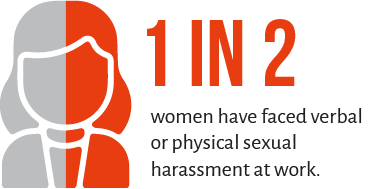
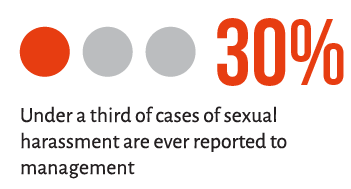
575 survey respondents, from eight countries, namely Kenya, Malawi, Zambia, Zimbabwe, Botswana, Tanzania, Uganda and Rwanda, responded to questions on sexual harassment at work - verbal and/or physical. It found:
Fear prevented many from filing formal complaints. These were the common concerns:
The absence of and lack of awareness of reporting mechanisms also explained inaction.
Almost half, 46.7%, of those surveyed said their organisation had no sexual harassment policy, 35.9% were unaware of what was in the policy and just 17.4% were aware of its contents.
Of the 32 managers interviewed 68.7% said their organisation had a sexual harassment policy - 46.7% had been trained on it.
Perhaps the biggest impedance in reporting is that the perpetrators are often managers or supervisors - people with responsibility and power. Survey respondents identified their harassers as fellow employees (in 38.8% of cases) but 22.1% of the time they were direct supervisors and in 19.4% of cases, members of higher management.
When action was taken in 57% of cases reported, the most common organisation response was to warn the perpetrator (46.2%). 14.5% of responses said training was offered and 9.7% had the case dismissed.
“The research highlights a lack of trust in the organisation, or sometimes complete failure of management and systems, to deal effectively with sexual harassment,” said Melanie Walker, WAN-IFRA’s Executive Director, Media Development and Women in News.
“This matters because the less confidence there is in an organisation’s ability to address the problem, fewer people will see value in calling it out, and so the cycle will perpetuate.” There are solutions, however, beginning with owners and managers acknowledging the problem exists and then committing to ensuring a safer working space, not just for women, but for all staff. It is vitally important to change the culture of silence around harassment. And this culture change can only come from the very top.”
In supplementary interviews with 32 media managers, we found
“There are divergent views on the scale of sexual harassment between the survey respondents and managers we interviewed. There is no simple explanation for this - but what is common is that both staff and managers have had first-hand experience of sexual harassment, and in most cases chose not to report it. This suggests fear of victimisation runs alongside a lack of confidence in management systems and any apparent remedies,” said Walker.
Women in News, which offers expert input on how to manage sexual harassment, is starting to see little victories among those media organisations that have begun to actively manage the problem - starting with adopting policies and procedures that the staff can support. “But the numbers are very small and we have a very long way to go before staff are convinced and comfortable that if there are incidents of harassment, they can report them, and action will be taken, without further victimisation,” said Jane Godia, Africa Director of WIN and an expert and trainer managing sexual harassment.
“We are still working on changing perceptions and debunking cultural beliefs that perpetuate sexual harassment,” said Godia.
This research has provided evidence of the need for media organisations to recognise the extent of sexual harassment and put in plans steps to provide a safer working environment.
“It all starts with a conversation on what is and isn’t acceptable behaviour in your media organisation. - being explicit about sexual harassment - sharing definitions, what behaviours are unacceptable, and communicating the right for every employee to be treated equally. It is not enough to have a policy; staff and managers must be trained on what the procedures are for making and managing a complaint. Everyone should be clear about the consequences of sexual harassment. It is far better to be proactive and prepared than pushed into a crisis management position when a case emerges,” said Walker.
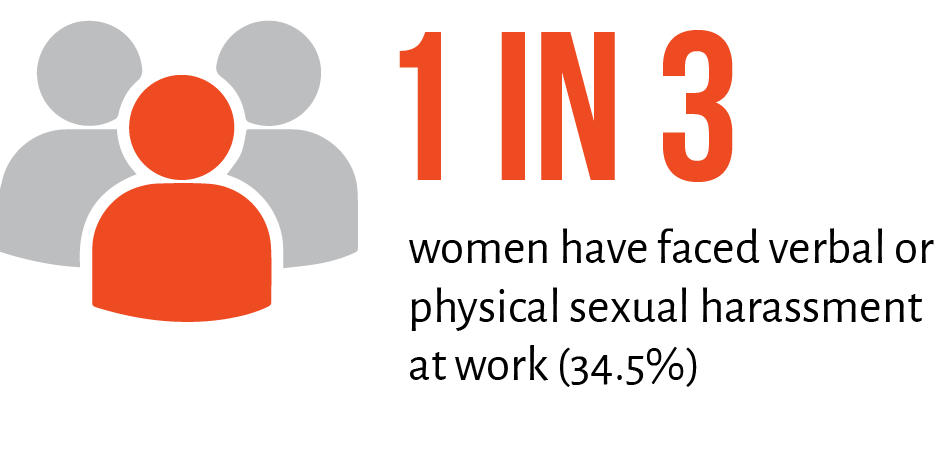
The way media organisations are managed is, generally, influenced by a belief that employees know how to behave. However, the reality is that sexual harassment remains quite prevalent - particularly for women - and often goes unreported. With less than one in six cases being reported to management, a culture of silence and fear persists.
This problem is compounded by a discrepancy between executives and employees on the scale of the problem. Despite one in three women having faced sexual harassment at work, 84.1% of executives interviewed believe sexual harassment isn’t a problem in the news industry. This is a significant perception gap.
These results form part of a multi region-study to provide the evidence of the extent of sexual harassment. The full research will help better understand the similarities and differences facing media in the Global South.

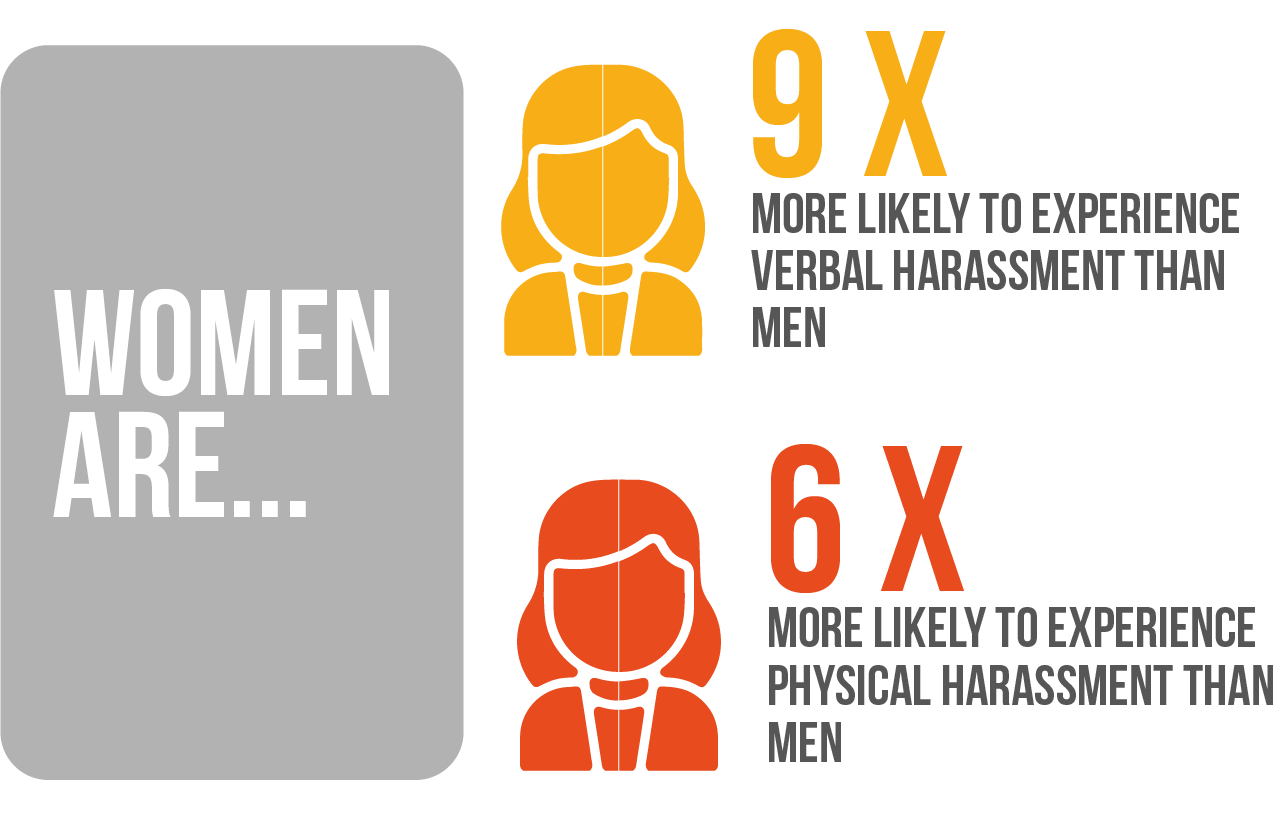
494 survey respondents, from five countries, namely Indonesia, Myanmar, Malaysia, Philippines, and Vietnam, responded to questions on sexual harassment at work - verbal and/or physical. It found:
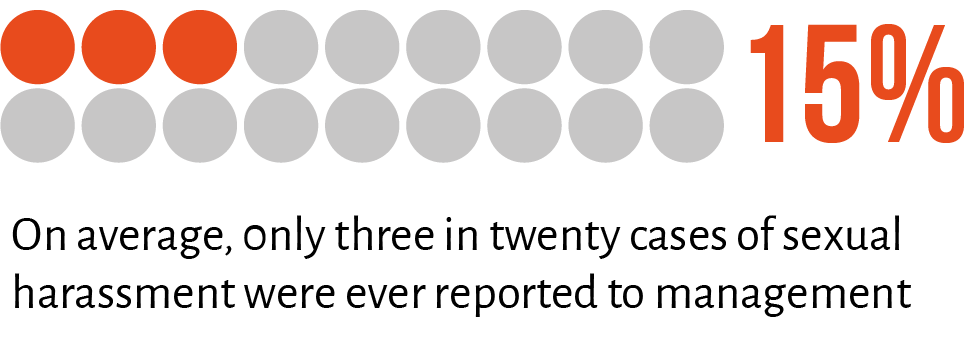
Underreporting of sexual harassment is endemic at both the employee and executive level. Along with the 15% reporting rate of survey respondents, executives themselves only reported incidents that happened to them 33% of the time (six of the 19 executives who had experienced sexual harassment however only two had reported it).
Of course we would like to see action always be taken, but with only 42% of executives indicating they were aware of their company’s sexual harassment policy the results are unsurprising.
In supplementary interviews with 19 media executives, we found
Increasing education about sexual harassment policies and how to implement them are a first step to improving the instances of action being taken. With only three of the eight executives who knew about the policies having been personally trained, this could make a big impact. This is supported by the more than half of executives who called for more training on what constitutes sexual harassment and how to respond.
Perhaps the biggest impedance in reporting is that the perpetrators are often managers or supervisors - people with responsibility and power. Survey respondents identified their harassers as fellow employees (in 35.2 % of cases) but %, 18.6% of the time they were members of higher management and in 12.7% of cases, direct supervisors.
“The research highlights disagreement about the prevalence of sexual harassment in newsrooms. 73.6% of executives believe it isn’t a problem, with an additional 10.5% believing it is a thing of the past. This is in stark contrast to the just over one in three women who have experienced some form of harassment at work - as well as the 4% of men,” said Melanie Walker, WAN-IFRA’s Executive Director, Media Development and Women in News.
“This is problematic because the first step in addressing sexual harassment is understand what it is and agreeing that it exists. We are glad to see executives agreeing that more training is needed to better understand sexual harassment and how to manage it. We are optimistic that continuing to work with media organisations across the region will help redress disagreements or misunderstanding.”
Women in News, which has recently expanded into Southeast Asia, offers expert input on how to manage sexual harassment. Working directly with newsrooms as well as individuals through the Leadership Accelerator, managers and employees can be equipped with the policies and procedures to actively manage the problem. But perhaps even more importantly, individuals get help to understand their rights and media organisations understand their responsibilities. “It is a long road ahead, starting with building a common understanding of what sexual harassment is and why it persisits. Removing it from every newsroom will create safer working environments and ones in which women can more easily thrive,” said Khin Thandar Htay, Southeast Asia Director of WIN.
This research has provided evidence of the need for media organisations to recognise the extent of sexual harassment and put in plans steps to provide a safer working environment.
“It all starts with a conversation on what is and isn’t acceptable behaviour in your media organisation. - being explicit about sexual harassment - sharing definitions, what behaviours are unacceptable, and communicating the right for every employee to be treated equally. It is not enough to have a policy; staff and managers must be trained on what the procedures are for making and managing a complaint. Everyone should be clear about the consequences of sexual harassment. It is far better to be proactive and prepared than pushed into a crisis management position when a case emerges,” said Walker.
Women in Russian media are four times more likely to experience sexual harassment than men. A report on the scale of sexual harassment in Russia has shown how pervasive it is, yet just one-quarter of cases are ever reported to the management.
The research, commissioned by the World Association of News Publishers’ (WAN-IFRA) Women in News programme found that of those women media professionals who experienced harassment, 31% experienced verbal harassment and 14% experienced physical attacks. 22% of media professionals (men, women and gender non conforming individuals) report to experiencing harassment or some kind.
The survey, which is part of a multi-region study undertaken in partnership with City, University of London, set out to collect data on the scale of sexual harassment in media organisations in Russia, and to establish what was being done to provide safer newsrooms. 176 media professionals were surveyed. Supplementary in-depth interviews were conducted with 16 media executives.
WIN has been engaging with journalists and media managers on sexual harassment for more than 10 years. In that time, we have collected plenty of anecdotal evidence of sexual harassment. But this is the first time we have been able to draw on large-scale data to support the belief that it is prevalent everywhere and is a significant impediment to a healthy media industry, regardless of country or cultural context.
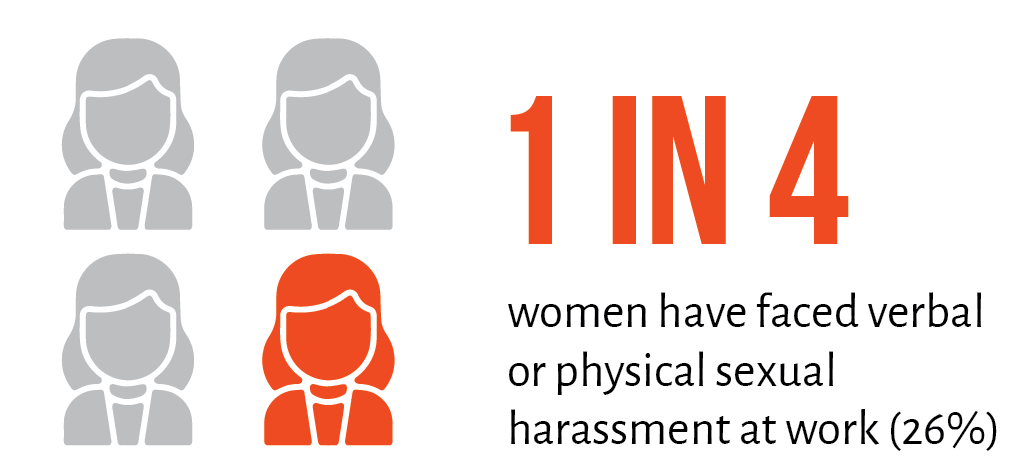
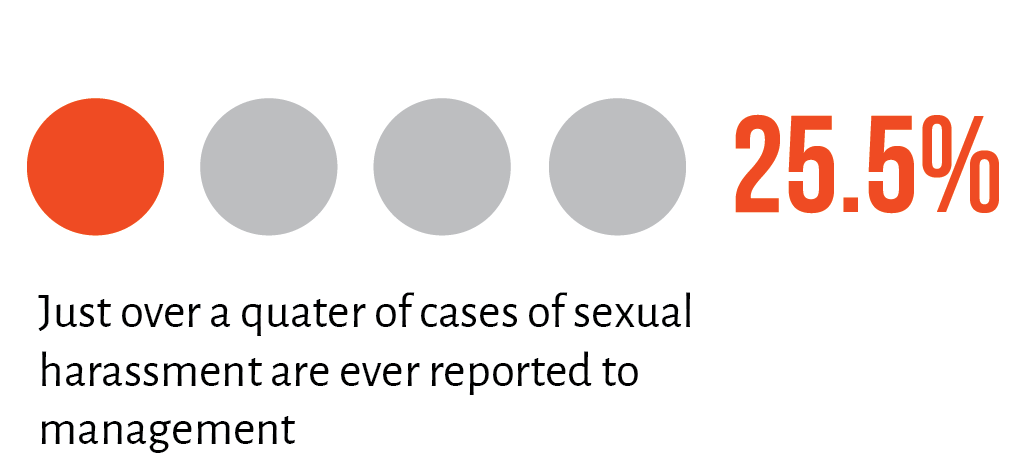
While sexual harassment in newsrooms for women is much more prevalent, men have not been spared.- though they are four times less likely to experience it than women, of those surveyed, 12 per cent had experienced verbal sexual harassment. None of them had been physically harassed.
Overall, just under one in four respondents (23.4%) had witnessed at least one incident of sexual harassment at work – but reporting of these cases remained low at 25.5 per cent.
The survey found:
In Russia, an average of 25.5% of cases of sexual harassment were reported to the management at media organisations. While 62% of these result in action by management, the low reporting rate means the majority of perpetrators are never disciplined and survivors never receive support.
Fear - fear of losing a job, negative repercussions, retaliation or being negatively labelled - was the prevailing reason for not reporting. Combined, it represents 39.7% of responses.
The top individual reasons \were no known reporting mechanisms (17.1%) and not thinking it was a big deal (15.3%).
Further, when respondents did report sexual harassment, news organisations took action less than two-thirds (62%) of the time. The most common responses from organisations when they took action were:
Direct action against the perpetrator almost never occurred. Firing, transfer, and suspension of the perpetrator were each only reported one time. The most common source of sexual harassment were fellow employees, followed by management (34.2%, combined total of direct supervisor and higher management).
“Understanding abuse of power is crucial to understanding who sexual harassment happens to and why. It tends to have nothing to do with sincere sexual or social interest. Instead, it happens where there are unequal relationships, for example between a superior and their subordinate, or between an older employee and a younger employee,” Melanie Walker, Executive Director, WAN-IFRA Women in News.
When asked if sexual harassment is an issue in the news industry, 15 news executives responded no, and one said maybe. This is in stark contrast to the 35% of women who reported experiencing verbal sexual harassment and 17% who reported experiencing physical harassment. This gap may also explain why 35% of responses said that organisational barriers, such as no reporting mechanism, not knowing how to report or thinking they wouldn’t be believed, were why they didn’t report the harassment they experienced.
To understand management perspectives on the prevalence of sexual harassment, WIN interviewed 16 managers and executives: 11 were women and five were men.
Three women stated they had experienced sexual harassment, but none had reported this.
The consensus between the news executives was that sexual harassment may occur in Russia in general, but it was an issue to be reported on, not one that was experienced by news personnel.
“I don’t think sexual harassment is a problem. If an issue arises, staff know how to defend themselves. Moreover, I have women who will fight back against anyone if this happens. We are all in a transparent environment; we see each other,” said one editor-in-chief.
“It is difficult for me to answer this question unequivocally. The honest answer: more likely yes than no,” said a deputy editor-in-chief.
When asked if any of their employees had reported cases of sexual harassment to them, three of the 16 executives answered yes, and their response was to discuss the incident with those concerned.
On reduced complaints, one CEO said: “Since the beginning of the #MeToo movement, many men have been rethinking their actions. Nonetheless, I remain concerned about sexual harassment and realise we can do better.”
Interestingly, when we asked respondents if their work environment was supportive, for women, 76.2% somewhat to strongly agreed they could openly talk to their supervisor, 88.1% somewhat to strongly agreed they felt listened to at work, and 88.8% somewhat to strongly agreed they felt safe in their newsroom. This seems to be in contrast to their experiences.
In response to a question on whether or not the executives believed their employees felt comfortable reporting sexual harassment incidences to their news organisations, 12 said yes.
“I’m sure about the women. They certainly would tell. They always talk about their problems: from health problems to personal dramas and breakups. With men, I’m not so sure. A man should deal with his problems on his own - this is the Russian mentality. You’re not a man if you show your weakness or ask for help,” said one general director.
Executives’ beliefs that sexual harassment is a non-issue in their workplace contrast with the respondents’ views, where one in four women have experienced either unwanted verbal or physical harassment at work.
Respondents said the perpetrator was most likely a fellow employee but that they do receive significant unwanted attention from people in power in the organisation - namely supervisors and executives.
The overarching stand from managers that there was no need for explicit sexual harassment policies and procedures may explain why reporting is low. A common reason for not reporting was dismissing the event as no big deal. However, one respondent pointed to a feeling of shame around verbal harassment, in line with cultural norms that silence victims.
Additionally, when asked if they knew if their organisations had an anti-sexual harassment policy, of the 16 news executives, only two were aware of such a document. And when asked to provide suggestions for eliminating sexual harassment in the news industry, they focused on the importance of communication in creating a comfortable atmosphere. Most executives believe this exists in their workplace, therefore, sexual harassment is not a significant issue.
The research findings go beyond anecdotes and demonstrate that sexual harassment does exist in Russian media organisations. The managers’ confidence that their workplaces, with their open communication policies, are not hotbeds for harassment, feeds into the notion that sexual harassment is a problem of the past and continues to create unsafe work environments for all of their staff.
The first step is making sure executives really understand what constitutes sexual harassment and just how pervasive it is. Only from there can policies be enacted and working cultures change to stamp out this scourge from all media organisations and, ultimately, all workplaces in general.
“The study showed that many publishers try to create an open, friendly atmosphere in their newsrooms and sincerely believe that this protects against harassment. But incidents can happen in any team and in any organization. It is important to know what to do and how to proceed in this case in order to protect people. You should have the reporting mechanisms, the investigative procedures and rules, the understanding of actions in response. The study revealed they do not exist, or employees do not know about them. Together with WIN WAN-IFRA, ANRI-MEDIA is taking very first steps in this direction to help media outlets create a safe business environment. For example, we adopted a WIN Guide on countering harassment in the media with practical templates and recommendations." Anna Koshman, ANRI-Media
Although 85% of sexual harassment incidents go unreported in the Arab media industry - management is starting to take some concrete actions to break the circle of silence.
526 media professionals participated in a survey from February to April 2021 distributed in Egypt, Jordan, Lebanon, and Palestine as part of a multi-region study to provide evidence of sexual harassment in the media industry. Just over half of the participants were women (54%).
On average one in three women have faced some form of sexual harassment at work (35%). More than 50% have experienced verbal harassment. Yet only 12% of incidents are reported. Men are more likely to see action taken on their behalf. On average, 50% of cases reported by men received action from their organisation, compared to 41% for women.
In addition, when asked if their organisation has an anti-sexual harassment policy, only 7% said there is one in place and they are aware of it.


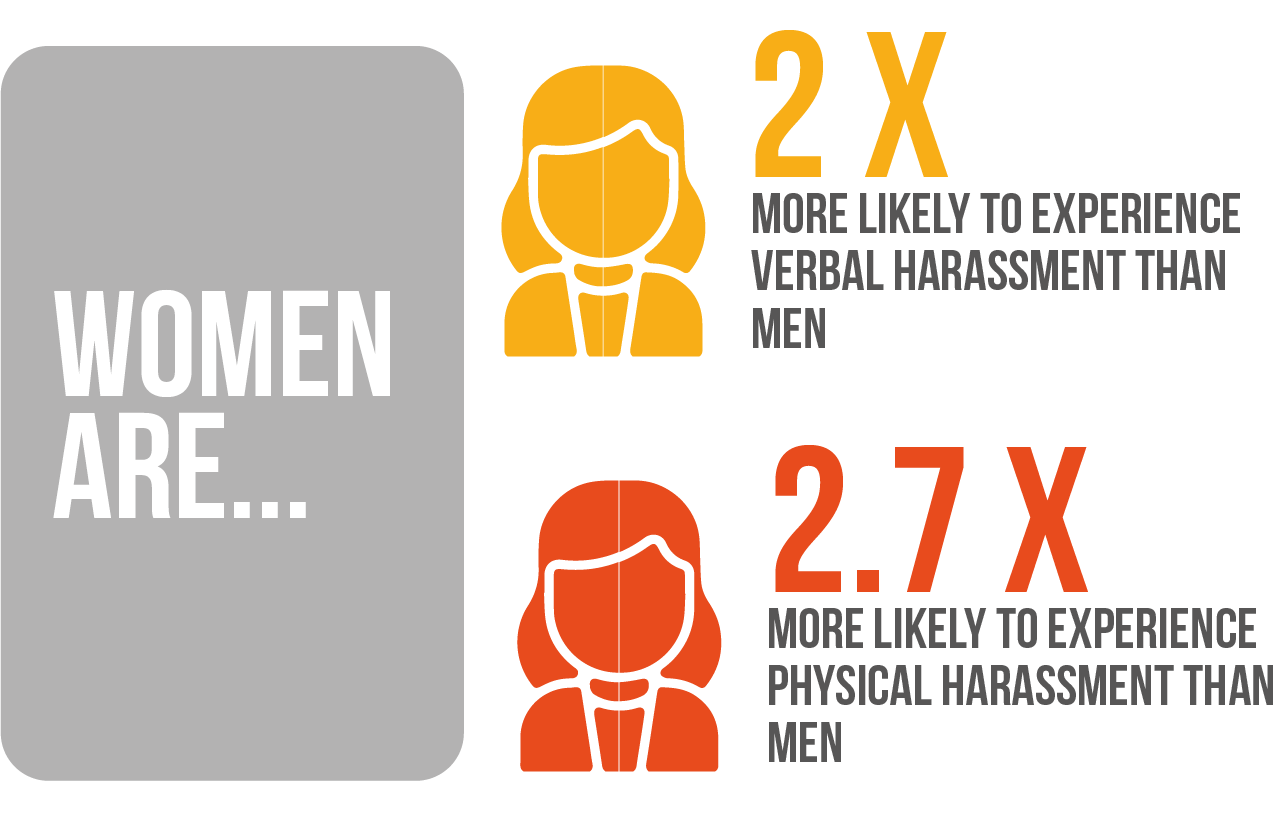
When respondents were asked questions on types of sexual harassment they faced at work women were almost twice as likely to experience verbal harassment compared to men, 52% and 24% respectively. The gap expands more when comparing data on physical harassment (19% and 7%).
Though a small sample size, of respondents who did not specify their gender in the study (almost 15% of the total responses), 29% experienced verbal sexual harassment, 14% experienced physical sexual harassment.
Furthermore, one in two participants stated that they have witnessed sexual harassment - 13.5% five or more times.
The results of this study reveals that sexual harassment is still existing, profoundly, in the media sector, which stresses the need and importance of taking actions to deal with it in an effective way.

Underreporting of sexual harassment is endemic. Providing safe space to talk freely about those cases, and guaranteeing confidentiality and protection are needed, in addition to raising the awareness of speaking up, showing the added value of protecting others from witnessing such recurrent situations.
Yet, of those reported cases, news organisations took actions 46% of the time, a step forward to activate the organisational role in ensuring safety and security of employees at the work environment.
The top reasons listed for not reporting were no known reporting mechanism available (17.3%), not having evidence (13.8%), and not wanting to be negatively labelled (12.8%). The most common responses of organisations when they took action was firing the accused (24.5%), and dismissing with no further action (20.5%).
The reasons for not reporting are brilliantly revealing the way to increase reporting rates: adapt a clear and comprehensive mechanism that applies fair rules, which help change the organisational culture to embracing openness and transparency instead of shame and blame paradox.
AR respondents revealed that the most common source of sexual harassment was a fellow employee (42.9%), followed by direct supervisor (22.2%), higher management (14.6%), other (10.7%), and news source (9.5%).
Numbers show that most sexual harassment incidents happen inside the media organisations at work, whether by the same level of management employees or higher. Firm procedures to help all staff members enjoy a safe workplace is a must.
This research has provided evidence of the need for media organisations to recognise the extent of sexual harassment and put in plans steps to provide a safer working environment.
“It all starts with a conversation on what is and isn’t acceptable behaviour in your media organisation. - being explicit about sexual harassment - sharing definitions, what behaviours are unacceptable, and communicating the right for every employee to be treated equally. It is not enough to have a policy; staff and managers must be trained on what the procedures are for making and managing a complaint. Everyone should be clear about the consequences of sexual harassment. It is far better to be proactive and prepared than pushed into a crisis management position when a case emerges,” said Melanie Walker, Executive Director, WAN-IFRA Women in News.
The media industry in Nicaragua and El Salvador has a sexual harassment problem. On average, 74% of women in media have experienced verbal sexual harassment. More than 40% have experienced physical harassment. These are amongst the highest rates of sexual harassment of all countries surveyed in the 20-country study, completed in November 2021.
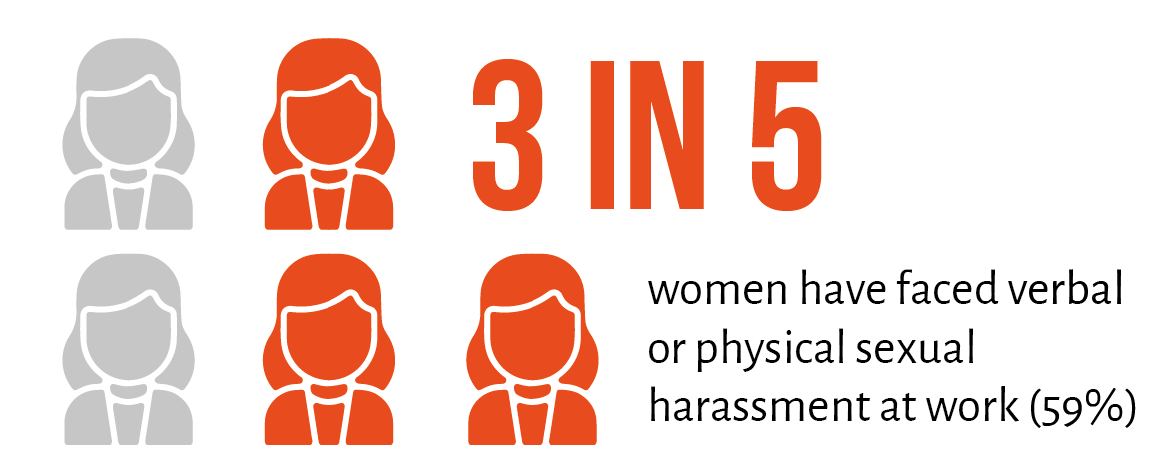
234 media professionals in Nicaragua and El Salvador participated in a survey, in addition to 18 media executives who provided supplementary in-depth interviews to understand the extent of sexual harassment in the industry.
The data shows that women are disproportionately affected, experiencing verbal and physical sexual harassment at least four times more than men. Moreover, women experience sexual harassment far more often than men, with almost half of the women surveyed indicating they have experienced verbal sexual harassment five times or more, compared to 5.8% of men.

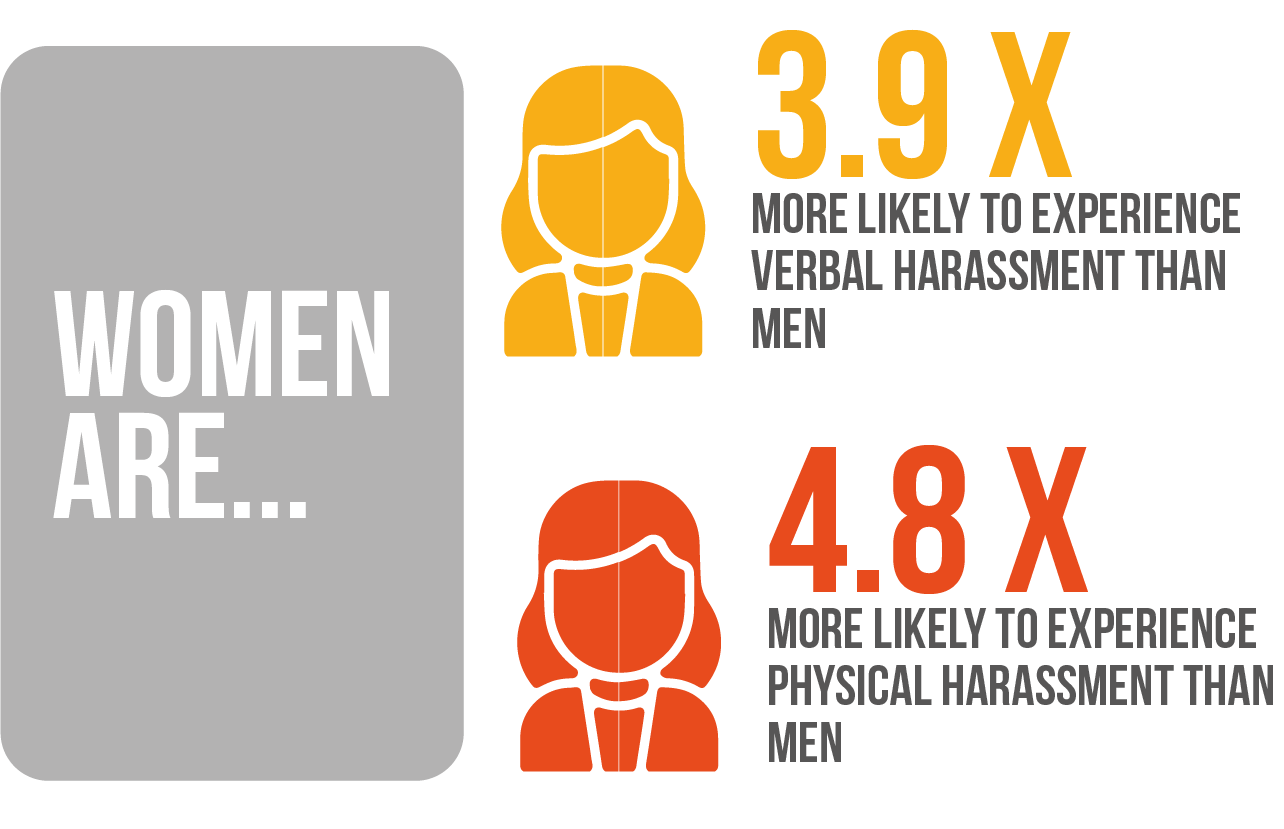
Given these high figures, it is not surprising that almost 60% of the participants had witnessed at least one incident of sexual harassment with 21% stating they had seen five or more. The most common source of sexual harassment was a fellow employee (42%), followed by higher management (25%).
Despite the high prevalence of sexual harassment, on average only one in every four cases was reported. Action was taken in just under half (46%) of incidents that were reported. Responses from both survey participants and news executives indicated the lack of a known sexual harassment policy. This is reflected by the survey respondents, where the top reasons for not reporting cited were ‘no known reporting mechanism available’ and ‘not knowing how to report’. The other reasons for not reporting were ‘fear of perpetrator retaliation’ or ‘fear of a negative impact in their professional career’.

Interestingly, when the interviewed news executives were asked if sexual harassment was a problem, the majority said yes, but not in their newsroom. More than half of the news executives interviewed stated that their newsrooms were exceptions to the overall atmosphere in the news industry, were sexual harassment was common.
The most common responses of organisations when they took action was warning the perpetrator (56.4%), offering emotional support for the victim (16%), and the victim being transferred to another department (10.3%).
Media organisations in Central America need to recognise the extent of sexual harassment and put in mechanisms to provide a safer working environment. The research shows that sexual harassment is a significant problem. The lack of policies aimed at preventing sexual harassment and at addressing it properly when it occurs, along with the common fear to report results in high levels of sexual harassment in the Central American media industry that go largely unchecked.